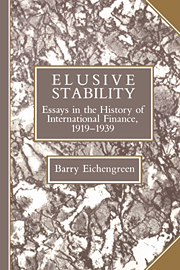Book contents
- Frontmatter
- Contents
- List of tables
- List of figures
- Acknowledgments
- 1 Introduction
- 2 Real exchange rate behavior under alternative international monetary regimes
- 3 Understanding 1921–1927: inflation and economic recovery in the 1920s
- 4 Bank Rate policy under the interwar gold standard
- 5 The Bank of France and the sterilization of gold, 1926–1932
- 6 International policy coordination in historical perspective: a view from the interwar years
- 7 The economic consequences of the franc Poincaré
- 8 Sterling and the tariff, 1929–1932
- 9 Exchange rates and economic recovery in the 1930s
- 10 The gold-exchange standard and the Great Depression
- 11 Hegemonic stability theories of the international monetary system
- References
- Index
6 - International policy coordination in historical perspective: a view from the interwar years
Published online by Cambridge University Press: 21 March 2010
- Frontmatter
- Contents
- List of tables
- List of figures
- Acknowledgments
- 1 Introduction
- 2 Real exchange rate behavior under alternative international monetary regimes
- 3 Understanding 1921–1927: inflation and economic recovery in the 1920s
- 4 Bank Rate policy under the interwar gold standard
- 5 The Bank of France and the sterilization of gold, 1926–1932
- 6 International policy coordination in historical perspective: a view from the interwar years
- 7 The economic consequences of the franc Poincaré
- 8 Sterling and the tariff, 1929–1932
- 9 Exchange rates and economic recovery in the 1930s
- 10 The gold-exchange standard and the Great Depression
- 11 Hegemonic stability theories of the international monetary system
- References
- Index
Summary
Measures of currency reform will be facilitated if the practice of continuous cooperation among central banks of issue, or banks regulating credit policy in the several countries can be developed. Such cooperation of central banks, not necessarily confined to Europe, would provide opportunities of coordinating their policy, without hampering the freedom of the several banks.
(From Resolution 3 of the Report of the Financial Commission of the Genoa Conference, 1922.)In the days of the gold standard, it is sometimes said, international policy coordination was a moot point. Popular accounts based more on caricature than on careful historical analysis portray the gold standard as a remarkably efficient mechanism for coordinating the actions of national authorities. Policies were so easily reconciled, it is argued, because those responsible for their formulation, regardless of nationality, shared a belief in balanced budgets and a common overriding objective: pegging the domestic currency price of gold. When central banks intervened in financial markets, it is suggested, they did so mechanically, obeying ‘rules of the game’ which dictated that they only reinforce the impact on domestic money and credit markets of balance of payments conditions. For example, a central bank losing reserves would raise its discount rate while the central bank gaining reserves would lower its discount rate, thereby reinforcing one another's efforts to restore external balance. Hence monetary policy under the gold standard is a favorite example of those who argue that international policy coordination is most readily achieved under a rules-based regime rather than one that depends on discretion.
- Type
- Chapter
- Information
- Elusive StabilityEssays in the History of International Finance, 1919–1939, pp. 113 - 152Publisher: Cambridge University PressPrint publication year: 1990
- 1
- Cited by



